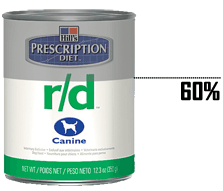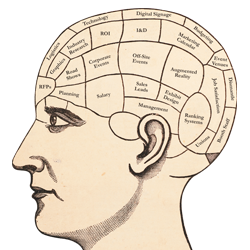research |
 |
 tats and research are about as sexy as cat kibble. While this data is key to proving the value of any exhibit-marketing program, typical marketers simply aren't turned on by it. tats and research are about as sexy as cat kibble. While this data is key to proving the value of any exhibit-marketing program, typical marketers simply aren't turned on by it.
 |
| ALL-STAR AWARD |
 Amy Gregory, CTSM candidate and senior veterinary conference planner at Hill's Pet Nutrition Inc., helps plan and execute 22 veterinary conferences each year. In addition to overseeing the conferences, Gregory has taken a lead role in the building and launching of two new exhibit properties for the company. Amy Gregory, CTSM candidate and senior veterinary conference planner at Hill's Pet Nutrition Inc., helps plan and execute 22 veterinary conferences each year. In addition to overseeing the conferences, Gregory has taken a lead role in the building and launching of two new exhibit properties for the company.
|
 |
Amy Gregory, however, isn't your typical marketer. The senior veterinary conference planner for Hill's Pet Nutrition Inc. doesn't only delight in data, she knows how to harness the power of research to effect program-wide improvements. In fact, between 2006 and 2008, Gregory implemented a research-based exhibit-marketing overhaul that not only helped cut exhibiting costs and increase booth traffic by an average of 41 percent, it won over Hill's internal skeptics, who couldn't help but succumb to the allure of her undeniable data.
Gathering this data, and ultimately revamping Hill's exhibiting program, however, wasn't Gregory's prime directive when she joined the company in February 2006. At the time, Hill's was relishing its market-leader position and basking in the status quo.
Founded in 1948, Hill's had developed a strong foothold in the consumer market with Hill's Science Diet pet food. It also practically owned the veterinary pet-food market with Hill's Prescription Diet - which aids everything from feline bladder control to canine bad breath - since a vast majority of veterinarians not only sold the prescription pet food, they recommended the over-the-counter Hill's Science Diet variety to their clients.
Then and now, Hill's attributes its success to its long-standing reputation as an industry expert and supporter - a reputation built on the fact that the Topeka, KS, company employs more than 150 veterinarians, Ph.D. nutritionists, and food scientists to create and improve products, and its scientists author more than 50 research papers and textbook chapters annually.
This pedigreed reputation even carries over to the veterinary trade shows it attends. Here, the No. 1 objective for attending veterinarians and veterinary technicians is obtaining continuing-education credits, followed closely by securing product information. Traditionally, then, Hill's sponsors oodles of continuing-education classes - with some even taught by its internal experts - and offers product education and a free veterinary textbook in its exhibit. So for the top dog in the industry, marketing isn't about generating awareness or gathering new leads. It's about maintaining loyalty, and ultimately sales, through high-visibility industry support and education - deliverables Hill's showers on attendees at its veterinary conferences.
Thus, when Gregory became alpha dog of Hill's veterinary trade shows in 2006, management hoped she'd merely maintain the exhibit program's "best of show" stature. But within a few weeks after taking the position, Gregory began to suspect that Hill's purebred persona was in need of a little grooming.
Even Good Ol' Dogs Get Fleas
While booth traffic was respectable and Hill's was satisfying its loosely defined education, sponsorship, and goodwill objectives, Gregory feared Hill's approach would soon become outdated in what had recently become a female-centric marketplace.
Between 1948 and 2000, Hill's achieved a loyal following among veterinarians, a predominately male profession at the time. But starting in the late '90s, a gender shift occurred, to the point that by early 2006, a vast majority - perhaps upwards of 80 percent - of veterinarians were female. And roughly 55 percent of these women were between the ages of 26 and 44. So in five to 10 years, Hill's veterinary target had shifted from a mostly middle-aged male audience with proven, long-term loyalty, to that of a young, recently licensed female audience that, while aware of Hill's, hadn't yet developed a golden retriever-like bond with it.
While Hill's had addressed this shift in most of its marketing, Gregory sensed that its exhibit-marketing program wasn't quite up to snuff. And upon closer inspection, Gregory identified several other components that weren't necessarily killing the company's exhibit program, but that would likely fester into life-threatening conditions if left untreated.
Topping her list of dubious program components were the company's aging exhibits, a seven-year-old island measuring 20-by-30 feet that was used for regional shows, and an 11-year-old double-deck island measuring 20-by-60 feet that was used for national shows. "Our booths were big, old, and weighty, and the graphics tried to tell attendees everything there was to say about our products," Gregory says.
While Gregory's diagnosis was dismal, the clinical, data-heavy approach was on par with the demands of Hill's previous target audience, i.e. middle-aged, male veterinarians. "But female vets are a whole different species," Gregory says. "To appeal to these relatively young women, we needed to move away from a double-deck steel structure that pounded its chest and said, 'We're a big old corporation; look at us.' The exhibit had to get away from a white-lab-coat feel that's cold and impersonal, and instead communicate that we are company that cares about the lives of pets and owners."
Gregory also felt Hill's in-booth experience delivered too much information and ate up too much of attendees' time. While Hill's had been luring attendees to its booth by giving out a different textbook year after year, booth visitors had to sit through four product-related PowerPoint presentations to obtain one - a process that took 35 to 45 minutes.
While retaining attendees that long is usually a marketing coup for an exhibitor, Gregory felt it was a coup de gras for Hill's. "We were info dumping," she says. "Each presentation talked about a different product, and each presenter offered at least five main points about that product. By the second or third presentation, attendees reached information overload and tuned out. They weren't learning anything; they were just going through the motions to get the book. And our objective isn't to hand out books, it's to deliver product education."
Similarly, Gregory felt the booth's traffic flow was detrimental. Since the four PowerPoint presentations were added years after the two exhibits were built, many of the required plasma screens were positioned so attendees had to stand in the aisles to view them. "Plus, the process was completely random," Gregory says. "Attendees could complete the four stations in any order and without a salesperson to escort them. So some people wandered in, watched a couple of presentations, zoned out, and then disappeared without ever talking to a salesperson." Each presentation also varied in length, so attendees couldn't proceed from one presentation directly to another. And with the double-deck exhibit, attendees had to visit the upper level to view one of the four required presentations, which created a bottleneck near the stairs.
While these problems alone are more than enough to make most exhibit managers turn tail and run, Gregory had an even greater challenge to address: the blind eye internal stakeholders seemed to possess.
"Despite the changing demographic and some of the obvious architecture issues, Hill's planned to maintain the status quo," Gregory says. "The logistics-based mentality was, 'This is how we always do it, so just dig in and get it done.' There simply wasn't any strategy discussion."
So as a new pack leader with a self-appointed directive to overhaul Hill's program, Gregory needed to not only develop innovative solutions, she also had to prove to management that the problems she'd identified actually existed.
|
Research-Based
Renovation
Amy Gregory's three-pronged research approach - including
a two-phase exhibit survey, message-memorability research, and data regarding veterinarians' communication preferences - helped her convince management that the status quo just wasn't cutting it. As a result, her two new exhibit properties incorporated several upgrades in keeping with the company's new target audience and messaging tactics. |
 |
 |
Ready to Retire
The previous booth was an imposing two-story structure that alienated attendees instead of welcoming them. |
|
 |
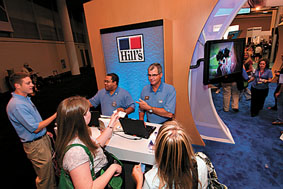 |
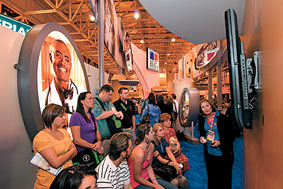 |
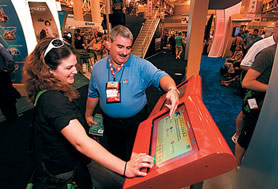 |
Fast Road to Redemption
After soaking up the exhibit's one-product message in roughly 15 minutes, attendees redeemed their RFID tags for a coveted textbook. |
Small-Group Presentations
Text-free images of vets and pets lined the exhibit, while presentations proceeded in a more logical "problem, solution, proof" order. |
Optional Product Kiosks
Rather than bombarding booth visitors with multiple product messages, six product kiosks aided only those attendees seeking more information.
|
Kibble, Kibble, and More Kibble
Despite her daunting challenges, Gregory ultimately turned to cat kibble, i.e. research, to transform her booth into a working class best of breed.
In July 2006, Hill's planned to exhibit at the American Veterinary Medical Association (AVMA) show in Hawaii. Prior to Gregory's arrival, the company decided to purchase a build-and-burn exhibit for AVMA to cut overseas shipping costs. One of her first major tasks with Hill's, then, was to help design this one-off exhibit. Not surprisingly, the resulting design addressed some of her yet unvoiced concerns, as it featured a more open floor plan, less architecture, lighter materials, a hanging sign instead of a giant two-story structure, and a less clinical and more emotional graphic feel. Gregory hoped that her slight amendments would open management's eyes to some of the exhibiting properties' issues.
When the exhibit debuted in Hawaii, Gregory's hopes were realized. "Everybody from senior management to salespeople to attendees loved the booth," Gregory says. "It was a total departure from what they'd been doing, and for the first time, management realized we might not need our big old booths to make an impact."
Faster than a calico with a cat-nip buzz, Gregory pounced at the slight crack in the status quo. Before the marketing team left Hawaii, Gregory met with attending marketing and sales managers to determine what they liked and disliked about the old exhibits and the one-off booth.
| |
 |
What Women Want
Since the late 1940s, Hill's Pet Nutrition Inc. had catered to a target audience that was predominantly male. But in the late 1990s, that target demographic - veterinarians - shifted from mostly male to nearly 80-percent female, triggering a change in the way Hill's marketed itself.
|
 |
 |
By the time her plane touched down in Kansas, she had a firm commitment from management to build two new booths within two years. Granted, management hadn't reached a consensus about what, exactly, wasn't working nor what, specifically, should be changed. But their eyes had opened to new possibilities and old problems, and they'd agreed to move ahead with the exhibit purchases.
"After the Hawaii show, the ball really started rolling," Gregory says. As soon as she returned from Hawaii, she pounced on the opportunity to initiate some research that would not only reinforce management's decision to build the booths, but also convince them that the company needed a whole new in-booth marketing strategy.
Almost immediately, Gregory called her exhibit house, 3D Exhibits Inc. of Elk Grove Village, IL, and one of its partners, Culture 22 LLC of Schaumburg, IL, and by late 2006, the trio had hatched a multi-step research strategy - the first of what would be Gregory's three research initiatives - to compare Hill's old booths against its proposed new ones. Gregory hoped that by pinpointing the exhibits' pros and cons she could keep the ball rolling down her intended path to success.
First, 3D created a near replica of the build-and-burn booth Hill's used in Hawaii. (Hill's then used this booth for regional shows in 2007, until the new properties launched.) Next, Gregory commissioned Culture 22 to perform two identical surveys regarding the effectiveness of Hill's old, double-deck structure vs. its new build-and-burn replica at two different shows with almost identical attendance figures.
The two-phase surveys included: 1) an exhibit assessment of visitor behavior, traffic patterns, and product presentations as observed by an outsourced marketing expert and a secret shopper, and 2) a visitor assessment, which surveyed attendees' opinions regarding the booth, product displays, and staff performance via personal interviews and online surveys offered in the booth.
Culture 22 administered the survey at the North American Veterinary Conference (NAVC) in January 2007, where the build-and-burn booth was used. It then administered the same survey to attendees at the Western Veterinarian Conference (WVC) in February 2007, where the old, two-story exhibit was used.
As Gregory suspected, each of the surveys revealed three key points: 1) The two-story structure was difficult to navigate, and at various times it appeared either overcrowded or empty, 2) many attendees wandered off before they spoke to a staffer; and 3) while the larger structure was impressive to some, it was intimidating and outdated to others. The survey also revealed that when compared to the double-deck exhibit, the one-off booth was superior in terms of traffic flow; plus, staffers could more easily interact with visitors in the open layout.
So with one data-infused swoop, Gregory secured statistical research that clearly identified the old booth's most critical issues, validated her concerns, reinforced management's decision to build the new booth, and practically ensured the redesign would incorporate her suggestions.
Next, Gregory turned her attention to the old exhibits' four-product focus. "I knew we were trying to tell attendees too much, but I couldn't prove it," Gregory says. "I needed an expert to prove a one-product focus would improve message memorability and keep attendees from bailing out of our presentations."
Gregory found her expert, namely Jerry Gerson, teaching a session at EXHIBITORFastTrak 2007 San Francisco, an educational conference for exhibit and corporate event managers. A corporate training associate at Marketech Inc., an exhibit and event marketing and training company based in Westborough, MA, Gerson had the research Gregory needed to convince management that attendees couldn't remember all of the product data Hill's was throwing at them. "He could prove that focusing on one product and a handful of key points, and then repeating these points several times, would create greater memorability," Gregory says.
Shortly after the show, Gregory implemented her second research-based initiative, as she brought Gerson to Hill's office, where he presented his data and persuaded management to switch to Gregory's one-product solution. "We convinced people that we shouldn't put the same old furniture into a beautiful new house," Gregory says. "We needed to take a different, one-product approach."
Around the same time Gerson was working his magic, Gregory was trying to determine which presentation format would best implement this one-product approach in the new exhibit. Luckily for her, Hill's marketing department had commissioned research and marketing firm Zyman Group LLC of Atlanta to analyze veterinarians' communication preferences. And as Gregory completed the RFP process on the new booths, Zyman came back with an answer: Veterinarians prefer a "problem, solution, proof" style presentation that offers information via an organized case-study approach.
Thus, Gregory implemented her third research initiative by applying Zyman's research to her program, as it proved the old booths' random traffic patterns and illogical sequencing wasn't working. Plus, the research helped Gregory convince management to use a one, two, three (i.e. "problem, solution, proof") approach to exhibit presentations, guiding attendees through Hill's product messages in a logical order.
A New Breed of Booth
Thanks to her research, Gregory had not only convinced internal skeptics that problems existed within the exhibit-marketing program, she'd used her data and instincts to develop innovative solutions to solve them. The value of her "smother them in statistics" approach wasn't lost on All-Star Awards judges, one of whom said, "She gathered good metrics via several methods, and her final results are impressive against a backdrop of internal misgivings." Another judge added, "With all of her data, Gregory was able to easily and effectively defend her spend."
Throughout 2007, 3D Exhibits implemented Gregory's solutions, eventually building two new properties, a 20-by-30 for regional shows, and a 20-by-60 for national shows. The new exhibits, with their new presentation strategy and one-product focus, debuted at the 2008 American College of Veterinary Internal Medicine (ACVIM) Forum, a regional show in San Antonio, and the 2008 AVMA in New Orleans.
While the casual observer might not have noticed stark differences between the old vs. the new properties, there were myriad contrasts in their details, not to mention their focus and flow - contrasts that equated to not only significant cost savings but also increased effectiveness.
Whereas the company's old exhibit properties were heavy, outdated, cold, and clinical, the new exhibits feature lightweight fabrics, less architecture, and an open, inviting feel. Gone were the text-heavy graphics; in their place were emotional, text-free graphics featuring images of people and pets. Overall, the environment was simple and emotional - and a direct hit with Hill's female target audience.
While Hill's retained the ever-effective textbook giveaway, the new one-product strategy and redesigned "problem, solution, proof" traffic-flow pattern also made it easier for attendees to obtain a book, and to retain Hill's key messages.
After staffers swiped attendees' badges and handed them an RFID card, they escorted the visitors to a waiting area, where another booth staffer chatted with them until a group of roughly 10 attendees had formed. The staffer then escorted the attendees to the first of three learning labs, which offered a presentation about a health problem that Hill's Prescription Diet Canine r/d pet food typically solves. After the presentation, a staffer again escorted the group to the second and later the third learning labs - the "solution" and "proof" labs, respectively - which featured the same key product messages established in the first lab.
To track their progress, attendees swiped their RFID cards at each learning station and later turned them in at Hill's redemption station to obtain their textbook. All told, attendees spent an average of 15 minutes completing the three stations.
After obtaining their books, attendees were free to wander the booth, which also featured six product-information kiosks. "The serve-yourself kiosks provided information about our other products," Gregory says. "That way we didn't bombard attendees with our other products, yet those that wanted to learn more could easily access the information."
Attendees could also talk with some of Hill's industry experts - including everyone from vets and product specialists to animal-nutrition experts - in a conference area. "If someone had a question in the old booth, we'd have to pull staffers off of their presentations to answer questions. Now we have a designated area in the booth that's staffed by our own industry experts."
Gregory's number crunching, however, didn't stop when the last attendee left the booth. Before the exhibits debuted, she charged Gerson with compiling stats about overall exhibit performance and tasked George Furman, vice president/account executive at 3D Exhibits, to compare and contrast logistics costs for the old vs. new properties.
Compared to 2007 results, book distribution at the 2008 ACVIM and AVMA increased 29 and 52 percent, respectively. While the figures indicate increases in the number of people that completed all learning labs, Gregory asserts that with the new one-product focus, these figures also indicate increases in product-message memorability. Gerson's data seems to support her assertion.
According to his exit survey performed at the 2008 AVMA, 60 percent of respondents indicated they were more inclined to prescribe Hill's Prescription Diet Canine r/d following their visit to the exhibit. Marketech's historical research has shown that, on average, 43 percent of booth visitors indicate they're more inclined to prescribe a product following a typical booth visit. Thus, Hill's results are 17 percent above average.
Finally, Furman's research indicated that while logistics expenses for the regional booth remained almost unchanged, the new design for Hill's national shows resulted in a significant decrease in the company's ongoing cost of exhibit ownership. He notes that compared to the old two-story structure, its new replacement is 8,000 pounds lighter, its rigging costs are 25 percent cheaper, and installation-and-dismantle charges are 20 percent less.
While naysayers might argue that Gregory merely redesigned two new exhibit properties, a closer inspection shows her improvements were far more complex than that. Using a three-pronged research approach, she not only redesigned her company's booths, she picked her program up by the scruff of its neck and improved its performance. e
|
|
|
|




 tats and research are about as sexy as cat kibble. While this data is key to proving the value of any exhibit-marketing program, typical marketers simply aren't turned on by it.
tats and research are about as sexy as cat kibble. While this data is key to proving the value of any exhibit-marketing program, typical marketers simply aren't turned on by it. 






